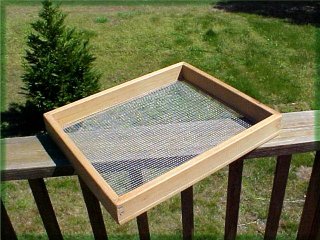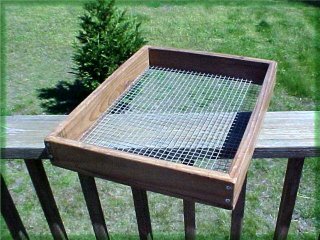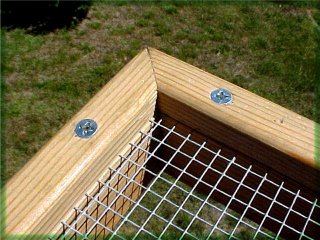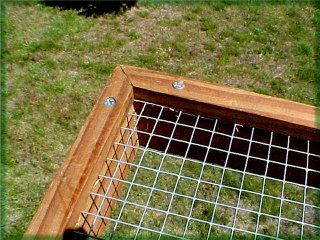If you hunt geodes, large specimens, or break your specimens from solid rock, then you won't need a sifting screen! If you hunt small minerals in dirt, look for them in creeks or streams, or have the need to wash gravel to find your next gem, then you will need some type of sifting screen!
This page will show you some of the different types that I've made over the years; all are custom made and used for different type deposits and conditions. No one sifting screen will work best under all conditions and you may find that it takes several to cover the areas you hunt.
The first consideration is opening size, this must be "smaller" than the mineral size in a deposit that you hope to find! It would be of little use to use a sifting screen with an opening to large to trap the minerals that's in a deposit...unless you just like to play in the dirt!
The next consideration is the "type" material used, many first time builders will use "hardware cloth". Hardware cloth is easy to find, most hardware stores and building centers stock this in rolls of different sizes. It comes in opening sizes from 1/8" to over 1/2". Hardware cloth is made from small gauge wire that is soldered together and then galvanized to prevent rust. This material isn't made for heavy use, after awhile the solder connections will break and the screen will need to be replaced. This material is not woven, the only thing keeping the screen together is the solder connections!
The best type of wire screen to use is called "woven mesh". This type material comes in different metal types, stainless, aluminum, brass, as well as regular carbon steel. You have a choice of many different wire and opening sizes to fit every type sifter that uses a wire type sifting screen.
The most durable material to use is called "perforated metal". This material is sheet metal that has holes punched in the sheet and comes in many different hole sizes, spacing, and metal gauge. You can buy this in just about any type metal, stainless would be a first choice for a sifting screen.
The first two sifting screens are standard picture frame or box type sifter using hardware cloth in 1/4" and 1/2".


Sifter with 1/4" hardware cloth (above left)
Sifter with 1/2" hardware cloth (above right)
You can make the above sifters using 1"x3", 1"x4", or 1"x6" wood boards, while using 1"x4" seems to be the standard. It is best to use a good grade of wood for your sifter, one without knots or other defects. I like to miter the corners and use screws and waterproof glue to hold the frame together, this will last much longer than using only nails. You could also use a regular butt-joint if you don't have a miter saw.

 Corner details
Corner details
You need to make your frame first before cutting you screen material, It's much easier to fit the screen to the final size of the wood frame. I also like to cut about 3/4" from the bottom side of each board to use as a cover for the metal screen. This will prevent the edges of the metal from "biting you" and hold it in place for a longer period of hard use. You also need to cut you metal screen "slightly" smaller to hide any sharp edges.
When you finish building your sifter, be sure to sand the wood to remove any rough places and coat it with wax or wood treatment. The following sifter was made using stainless perforated metal with 5/32" holes.
You can make your sifter any size, I've found it best to keep it around 16"x20". This makes it big enough to use and carry to a dig site. If you make the sifter to large, you will miss something by having to much material to search through... sounds strange, but true! I have seen box screens as big as 3'x4', with 1" openings... but they wasn't looking for ruby!
Sifters come in all sizes and types. Below are a few that I've made for special purposes or certain sites, they may give you some ideas that you can use? You can also buy commercial sifters in many types, or even find something in your kitchen that might work!
The following is a round sifter made to fit into a 5-gallon bucket filled with water, this is good to use if water is in short supply It's made of stainless sheet metal and perforated metal with 5/32" holes.
This next one is only used in about three locations where the material I'm looking for is bigger than the 3/4" opening size. The sifter is all stainless using 1/16" welding wire for the screen. Yes, it was a trick using that size wire to weave a screen!!
I made the following little sifter to carry in my back-pack on prospecting trips. It's only about 10"x14" and folds flat. It was made using stainless perforated metal and stainless piano hinge. four pins holds it together at the corners.
The next type is best used by two people because of the amount of dirt that can be used. It's about 20"x 30" when set-up. You may see a "roller" or "rocker" type sifter being used on larger pieces or when more than one person is using a sifter. I made the next one using all stainless, it even has its own carry bag!
I used stainless woven mess with a 1/4" opening size, the mess was around $40 for a piece this size... which was cheaper than my $500 labor! The sifter unfolds and locks with two latches, it uses stainless cables coming from two "two-piece" support poles.
The following sifter is a special one, not because we met Mike while we were using it for the first time:D... but because it works!
The next sifter has been used more by other people than me! This sifter and I have been the butt-end of many picture jokes on the McRocks.com message! I started to make a larger version of this sifter... the problem is, I haven't found a deposit big enough to need one! It is all stainless and uses perforated metal for the 8-sided cage, one "flat" is open for loading. When turned clockwise it sifts, turn it counter-clockwise it will dump your gravel from the bottom. It's painted a flat green to remove the flash when used in the sun and It works best when placed in water about 1/3 up on the cage. It is a fast way to sift dirt and easy to carry when not in use
I hope this will help you some on your next sifting screen project!
Best to ya!
Wayne